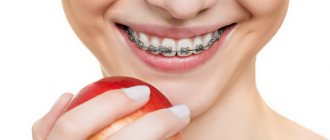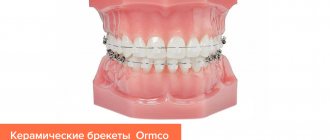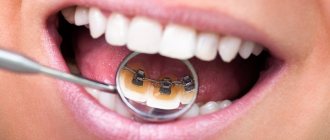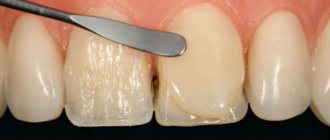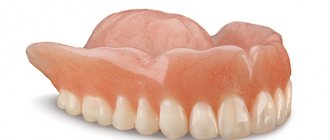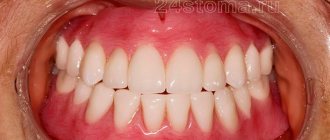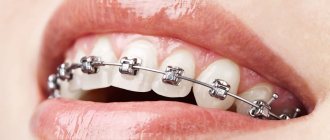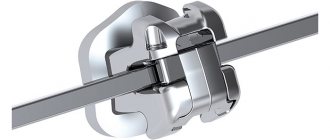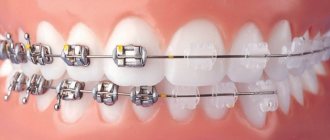Braces can be called one of the main ways to solve the problem of malocclusion and crooked teeth. More and more people who do not want to deal with such troubles are deciding to install them. Modern dentistry can offer a variety of options in this area, so it’s easy to get confused; for example, should a patient choose sapphire or ceramic braces? Or maybe classic metal ones? It is not so easy to answer this question; here it is necessary to consider all the options, their strengths and weaknesses, so as not to regret your choice later.
Kinds
To solve the problem of straightening the teeth, a modern orthodontist has an arsenal consisting of four types of braces: sapphire, metal, ceramic and lingual. At the moment, all these types of brace systems are used, but each has not only its own characteristics, but also its own disadvantages and advantages. For example, the most tried and tested option is metal braces, which work faster than others, cost less, but are inferior to their counterparts from an aesthetic point of view. Lingual braces are installed on the back of the dentition and are not visible to others at all, but their use is not always possible due to clinical limitations, so sapphire and ceramic braces can be safely called one of the most optimal options from all points of view.
System design features
Previously, not all patients agreed to get braces to correct their teeth. However, modern designs, unlike their predecessors, can be almost invisible and do not spoil a person’s smile. There are several types of braces used in dentistry. Each has its own functional features, advantages and disadvantages. Today we are talking about ceramic and sapphire. These are vestibular systems installed on the outside of the teeth.
An alternative to them is the most common metal braces. They appeared on the market a long time ago, you need to wear them less, they have an affordable price, but in terms of aesthetics they are significantly worse than ceramics and sapphire. Another variety is lingual. These braces are placed on the back of the teeth. They are good because they are completely invisible, however, such models have a number of contraindications and require a long time to get used to.
Indications for using braces are as follows:
- distorted dentition - distortion may not affect all teeth, but some. We may be talking about incorrect tilt and other defects;
- malocclusion and poor jaw closure - all this can provoke abrasion of tooth enamel;
- malocclusion due to tooth loss. If after this the patient does not have an implant installed, then the jaw gap narrows and the bite becomes incorrect.
Sapphire or ceramic braces can satisfy all the patient’s needs. They are better than others in many ways. For example, the alignment arch in them is covered with a Teflon layer and does not contrast against the background of the teeth, which makes the system less noticeable.
The new generation designs are ceramic and sapphire braces; there are differences between them, and they should definitely be taken into account when choosing.
Sapphire systems, despite the name, are not made from real jewelry material. They are based on artificial crystals. The metal inserts in them are replaced with aluminum oxide on a monocrystalline basis. At the same time, in terms of strength, this material is in no way inferior to metal, but successfully camouflages the product. Some of the benefits of sapphire include:
- quick addiction;
- ease of installation and removal of structures;
- comfortable to wear;
- ease.
Sapphire (there are metal ones on the chewing teeth to save money - they are not visible there anyway)
Due to their features, such products are very expensive. But at the same time they are very fragile and easily damaged. They are placed only in cases where problems in the oral cavity are not too serious. If the product breaks, you should urgently contact a specialist; if broken, it can change the direction of traction or injure the cavity.
Ceramic-based models are best suited when the teeth themselves are not too white. They, like sapphire ones, are comfortable to wear. At the same time, they are durable, hypoallergenic, and the risk of injury to the gums is low.
Ceramic with white arc
They are also not cheap, but are designed for longer use. In addition, when the structure is removed, the patient may complain of discomfort. Products are also susceptible to staining, so it is recommended not to eat foods containing artificial and natural dyes.
What is the first thing you pay attention to when choosing a braces system?
The invisibility of braces is one of the most common requirements from patients; accordingly, the appearance of the systems becomes a determining factor in the selection process. Of course, there is a difference between ceramic and sapphire products; they are made from various polymer materials. The nuance here is that the brackets of ceramic structures are selected to match the color of the teeth enamel as closely as possible, and sapphire locks are characterized by complete transparency, therefore, if the teeth are not perfectly white, then such a system will become noticeable to others. Another advantage of ceramics is the ability to achieve maximum cosmetic effect by varying the color of the product’s coating, which can result in a complete match with the color of the teeth.
An obligatory requirement on the part of the patient will be the absence of discomfort during eating. There is not much difference between these two systems; it is impossible to say that one is unconditionally better than the other, although it also has its own characteristics. The main differences will relate to the dietary preferences of patients, for example, for lovers of coffee and other drinks with strong coloring properties, ceramics are not suitable from an aesthetic standpoint, since it will soon change its color under the influence of these products. And you will have to completely give up foods such as nuts, candies or beets while wearing the structure. The sapphire system is more resistant to staining, but less durable than ceramic.
When choosing braces, you cannot be guided only by aesthetic considerations; you also need to take into account the duration of the upcoming teeth straightening process and the degree of neglect of the disease. For more serious and long-term cases, it is better to opt for metal braces; sapphire and ceramic products are effective for not the most difficult situations, the treatment of which does not require spending more than one year. The reason is simple - these systems are focused more on the aesthetic side of the problem and treatment with their help is slower.
Classification of ceramic products
Ceramic braces are divided into two groups:
- Polycrystalline.
- Monocrystylic.
The most popular are the first ones, that is, polycrystalline systems, characterized by the dullness of the coating and the ability to fully replicate the color of the teeth. Their use, however, is not always possible, since matte structures are not always suitable for a particular patient.
Monocrystalline braces are more transparent, they actually completely match the color of the enamel and are more comfortable, but they are fragile, susceptible to damage and take longer to operate.
Ceramic and sapphire braces: differences
Both of these systems are capable of coping with the loads placed on them, but only on condition that the patient has the right attitude towards them. The installation of such structures is associated with a number of difficulties; therefore, accuracy and precision on the part of the orthodontist play a vital role. The technology of this procedure requires that, for reasons of increasing operational reliability and reducing the risk of chipping, the products are obtained slightly larger than necessary. This results in the wearing process becoming less comfortable for the patient. It is possible to manufacture individual parts from metal, but in this case you will have to sacrifice the aesthetics of the treatment.
Caring for ceramic and sapphire braces should be especially thorough and careful, if parallels are drawn with metal analogues. This point also needs to be taken into account when answering the question: should the patient have sapphire or ceramic braces? The final decision is best made after consultation with a specialist and weighing all the positive and negative aspects.
Which braces are best to choose?
None of the patients would like to prolong the treatment time. Therefore, we can confidently say: it is better to choose a self-ligating system. If savings are important, then metal, and if you are willing to pay a little more for aesthetics, then ceramic. Of all the vestibular non-removable systems today, these are the most optimal options.
And for those who are not ready to wear a fixed structure, we can recommend aligners. With the development of this technology, it becomes more accessible and is often comparable in price to braces.
Read other articles:
What can aligners do? (Spoiler: almost everything)
Three situations when it is better to choose aligners
What is the installation process like?
Before installing a brace system, you must first perform a complete diagnosis of the oral cavity, take images and impressions of it so that the design fits the patient as accurately as possible. In general, installation is carried out in several stages:
- Complete teeth cleaning and oral health, treatment of each tooth with a special substance.
- Applying an adhesive element to the tooth surface in order to fix the brackets. Since the bite is individual, the installation level of each part is determined separately for each tooth.
- Pulling an arch through the brackets, which will allow you to establish the correct position of the dentition.
At this point, the installation is completed; further success will largely depend on the patient’s compliance with basic rules of hygiene and oral care:
- brushing and rinsing your teeth on a regular basis in order to prevent the development of caries; for this you need to purchase a special brush, brush and dental floss;
- exclusion from the diet of any types of sticky food that can compromise the integrity of the structure;
- ban on the use of chewing gum;
- Each meal should be completed by rinsing your mouth.
As you can see, there is absolutely nothing complicated in these rules, but following them will ensure correct and effective treatment.
Sapphire products
Such structures are made from artificial sapphires and are aimed at correcting defects such as sparseness of teeth, their twisting or inversion. The main advantages of sapphire braces are:
- invisibility to others;
- high aesthetics;
- low level of pollution;
- convenience and comfort to wear;
- do not interfere with diction;
- reliable in installation;
- resistant to the appearance of harmful bacteria and microorganisms;
- do not require complex care.
However, one cannot help but touch upon the issue of the shortcomings of such systems, namely:
- longer wearing period;
- quite high cost (from 25 to 50 thousand rubles);
- despite the strength of the manufacturing material itself, the entire structure does not have a high level of strength, which eliminates serious chewing loads on the jaw;
- due to the slight friction between the arc and the fastening groove of the structure, a slight shift occurs, which does not have a very positive effect on the treatment process.
Reviews
According to reviews from most patients, sapphire braces are easy to get used to. Already 2-3 days after their installation, the discomfort from the pressure on the teeth disappears.
Also, judging by the reviews of those who have installed sapphire braces, they do not cause pain, do not interfere with talking or eating, and are practically invisible on the teeth to others.
To summarize, it is worth noting that although sapphire braces are in great demand, they are less effective in correcting serious malocclusion pathologies. And despite the many advantages, their main disadvantage is their high cost. Therefore, the best alternative would be to install Star-Smile aligners. These orthodontic structures will correct the bite without wearing braces for a long time.
Yes and no in favor of braces
Having analyzed the main differences between sapphire and ceramic systems, we can come to certain conclusions about which of them is better for the patient. If you start with ceramic products, their undoubted advantages will be:
- the ability to choose a tone that perfectly matches the color of the enamel, this is especially important for those patients whose teeth are not dazzlingly white;
- ceramic braces are durable and reliable;
- they cling perfectly to the enamel;
- there is no violation of diction.
Sapphire designs also have something to answer for, since their strengths will be:
- ideal transparency of the product and almost complete invisibility on the teeth;
- this option is called one of the most reliable in terms of fastening the system;
- high resistance to staining;
- sapphires practically do not collect plaque;
- There are no problems with diction or complications in eating.
But, it should be noted that sapphire brace systems are more expensive than ceramic ones, so the patient should think everything through, weigh the pros and cons of each of these designs and, after consulting with a doctor, make a final decision.
Popular manufacturers
The leadership in the manufacture of sapphire bracket systems belongs to American manufacturers. They produce their products in a wide range, and constantly update their range. German companies are more painstaking in the production of sapphire braces and conduct clinical trials for a long time. Because of this, they are slightly behind their American colleagues. But their products are distinguished by high quality and affordable prices in Moscow.
Among the well-known manufacturers of sapphire bracket systems, it is worth highlighting the following companies:
- Ormco produces many orthodontic structures, but the most popular is the Inspire ICE braces. They are completely transparent and transmit both regular daylight and neon light well. They are characterized by high strength, durability and ease of wearing. These systems do not damage tooth enamel and can be easily and quickly removed if necessary;
- ZM has been producing equipment for correcting malocclusion for more than half a century. Their products have earned many prestigious awards and positive reviews from customers;
- American Orhodontics has been on the market for about 40 years and produces a wide range of all kinds of braces systems.
Features and rules of care
Regardless of the choice in favor of one system or another, you should follow several simple but important principles for caring for them and the oral cavity. This procedure is slightly different from the usual one, so you should not neglect the principles below:
- cleaning the oral cavity with installed braces takes longer, since you still need to spend time cleaning the structure itself;
- It is better to carry out hygiene at least three times a day, including rinsing after each meal;
- You should brush your teeth with special toothpastes that contain a higher content of calcium and fluoride;
- The spaces between the teeth need to be cleaned especially carefully; floss is excellent for this purpose;
- The system should be professionally cleaned at a dental clinic at least once every six months.
You will also have to come to terms with the presence of some categorical prohibitions, namely:
- no chewing gum;
- Sticky and sticky foods are not allowed;
- sweet consumption will have to be reduced;
- at least for the first time, do not eat ice cream or drink too cold drinks.
Care instructions
Whatever braces you choose, their integrity and longevity depend on how you care for them. Proper care is the same for both types and facilitates the adaptation process, which on average lasts up to seven days. During this time, the patient may experience some discomfort. It is recommended to pay more attention to dental hygiene issues. The rules are:
- You should brush your teeth very carefully - this should be done not only after waking up and before going to bed, but also every time after eating. There is a risk of pieces of food getting under the staples. Additionally, in addition to the brush, you can use a small special brush;
- You should use dental floss to clean the interdental space. Thanks to it, cleaning will be as complete as possible;
- the use of a mouth rinse - one or another type should be recommended by a specialist, taking into account the patient’s characteristics;
- It is recommended to additionally use an irrigator - it can significantly simplify the process of caring for the cavity, helping to rid it of plaque and remove food debris. However, it cannot be used if the patient has highly sensitive gums.
Although both materials are quite durable, it is recommended to follow a diet while wearing braces. You should avoid the following:
- solid food - because of it, the locks of the structure can be worn out;
- iris and chewing gum - they can stick to braces;
- combination of hot drinks and cold foods - this can negatively affect the elasticity of the staple arch.
In any case, you should avoid products that have a coloring effect. These are sweet carbonated drinks, coffee, wine and much more. Unlike ceramic products, sapphire products cannot be dyed, however, frequent use of products with dyes can also negatively affect their characteristics.
Let's sum it up
There is no clear answer to the question of which brace systems are better; there is no fundamental difference between them. If aesthetic considerations come first for the patient, then it is rational to give preference to transparent sapphire designs, but your choice should always be agreed with a specialist. For those who most value the wear resistance of the system and its reliability, ceramics would be the optimal solution; it is better to give it their preference, but even in this case, you first need to visit a doctor for a consultation.
There is no need to be afraid of installing braces; the treatment procedure will not cause any serious discomfort, but the result will allow you to fully enjoy life and not hide your beautiful and dazzling smile.
Types of orthodontic structures
Today, the possibilities of orthodontics allow each patient to choose the optimal method for correcting malocclusion. There are many types of braces, made from different materials and having different methods of fixation on the teeth. Depending on the material of manufacture, braces are distinguished:
- metal;
- ceramic;
- plastic;
- sapphire;
- titanium;
- combined (more discreet and aesthetic braces are selected in the smile area, and a more affordable option is installed on the remaining teeth).
Depending on the location on the teeth, braces can be external (vestibular) or internal (lingual). Based on fixation, a distinction is made between ligature and non-ligature (self-ligating) braces. Which braces are better, metal or sapphire, ceramic or titanium, is determined depending on the patient’s clinical situation, his wishes and financial capabilities. The choice of each of the parameters (material, method of location and fixation) affects the final cost of the bracket system. The more invisible it is, the higher the price will be.
